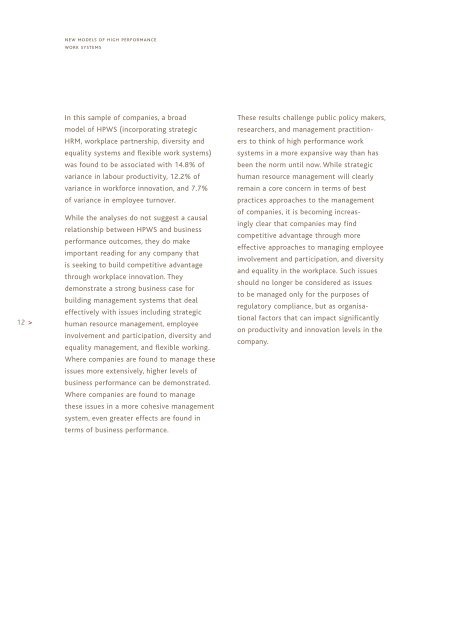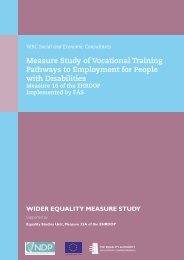New Models of High Performance Work Systems - Equality Authority
New Models of High Performance Work Systems - Equality Authority
New Models of High Performance Work Systems - Equality Authority
- No tags were found...
You also want an ePaper? Increase the reach of your titles
YUMPU automatically turns print PDFs into web optimized ePapers that Google loves.
new models <strong>of</strong> high performancework systems12 >In this sample <strong>of</strong> companies, a broadmodel <strong>of</strong> HPWS (incorporating strategicHRM, workplace partnership, diversity andequality systems and flexible work systems)was found to be associated with 14.8% <strong>of</strong>variance in labour productivity, 12.2% <strong>of</strong>variance in workforce innovation, and 7.7%<strong>of</strong> variance in employee turnover.While the analyses do not suggest a causalrelationship between HPWS and businessperformance outcomes, they do makeimportant reading for any company thatis seeking to build competitive advantagethrough workplace innovation. Theydemonstrate a strong business case forbuilding management systems that dealeffectively with issues including strategichuman resource management, employeeinvolvement and participation, diversity andequality management, and flexible working.Where companies are found to manage theseissues more extensively, higher levels <strong>of</strong>business performance can be demonstrated.Where companies are found to managethese issues in a more cohesive managementsystem, even greater effects are found interms <strong>of</strong> business performance.These results challenge public policy makers,researchers, and management practitionersto think <strong>of</strong> high performance worksystems in a more expansive way than hasbeen the norm until now. While strategichuman resource management will clearlyremain a core concern in terms <strong>of</strong> bestpractices approaches to the management<strong>of</strong> companies, it is becoming increasinglyclear that companies may findcompetitive advantage through moreeffective approaches to managing employeeinvolvement and participation, and diversityand equality in the workplace. Such issuesshould no longer be considered as issuesto be managed only for the purposes <strong>of</strong>regulatory compliance, but as organisationalfactors that can impact significantlyon productivity and innovation levels in thecompany.
















